Returning to the Yorktown | April 19, 1944
As we flew back to the Yorktown, it was time to jettison our empty drop tanks. In the event of a crash landing on the carrier, the tank—full of avgas fumes—could contribute to a nasty conflagration. Reaching my left hand down, just outboard of the throttle quadrant, I triggered the drop tank release switch and felt a brief bump as it fell away.
The airspace above the carrier resembled hornets buzzing around a nest that had been kicked. There were sixteen of us in the returning CAP, waiting to be recovered. I hoped it wouldn’t take too long, as I was getting low on fuel. Chasing the Betty had taken more gas than I realized.
“BLUE FLIGHT, this is CAIRO. Descend to three angels and enter the holding pattern. We’ll get you boys down as soon we can.”
“CAIRO, this is BLUE FLIGHT. Descending to three angels and holding.”
As we descended to the holding pattern altitude, I looked below and saw that the Yorktown was busy launching the afternoon CAP. The recovery evolution had not begun, and couldn’t until the current launching operation was done.
Landing a plane on an aircraft carrier takes an immense amount of skill, teamwork, and luck. There’s a reason why the Navy calls it “recovering” aircraft and not “landing” aircraft. From one perspective, you really don’t land an airplane on a carrier, you fly it into the deck and hope that the hook catches a wire and the landing gear doesn’t collapse.
Just a week earlier I’d creamed a Hellcat’s landing gear. Twelve Hellcats and sixteen Avengers had been launched on a practice strike. I was flying wing on Jonesy. We’d already flown two hundred miles from the task force when suddenly the weather closed in. Squalls, driving rain, the ceiling down to three hundred feet. We couldn’t see a thing and had no idea where the task force was. It certainly wasn’t where we left it because it moves at about thirty miles an hour.
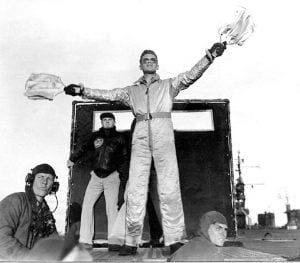
The Flight Leader finally pulled the plug on the mission, figuring it was foolish to risk life, limb, and aircraft on a practice strike. Flying in formation in that kind of soup can lead to midair collisions. We finally picked up the Yorktown’s YE, and were able to fly the vector back to the task force. When we got back to the carrier, we found the weather was just as nasty.
The Landing Signal Officer (LSO), himself an expert pilot, was standing with his paddles at his station, buffeted by squall winds and soaked to the bone by rain and sea spray. He was desperate to get us down safely, knowing that rescuing a ditched pilot in a turbulent sea was unlikely to be successful. Consequently the LSO might have signaled a cut now and then when he should have given a wave-off. When it was my turn, he brought me down a little steep and a little hot. My hook caught, but the impact twisted my landing gear and buckled my fuselage. Believe me, I was just happy to be back on the good old Yorktown. In light of the horrible conditions, there was no blame assigned to anyone. I promised to buy the LSO a beer next time we were in an anchorage.
My headphones crackled, bringing me back to the present. “BLUE FLIGHT, BLUE FLIGHT, this is CAIRO. The aircraft approaching from two-six-five degrees are friendlies, repeat, friendlies, the TBF has landing priority. Acknowledge.”
“CAIRO, this is BLUE FLIGHT. Copy that, aircraft approaching from two-six-five are friendly, the TBF has landing priority,” skipper acknowledged.
Now, who would that be, I wondered as I scanned my instruments. My eyes settled unhappily on the fuel gauge. Adding more aircraft ahead of me in the landing pattern was not helpful. I might have to ditch, I thought. I wasn’t going to bellyache about it, though, because there were probably several other Hellcats in the holding pattern that were also on the verge of a dead-stick landing. Get ready for a swim, boys.
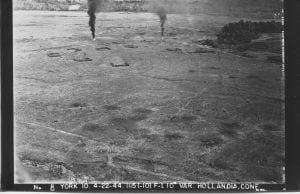
Orbiting in the holding pattern was pretty boring, so I kept my eyes pealed along the vector from which the newcomers were approaching. Finally I spotted them. It was a Grumman Avenger with four Hellcats escorting him. Then I remembered: a photo-recon mission had been launched ten minutes before our CAP. This particular TBF was configured as a scout plane and outfitted with a high-resolution camera. His mission was assessing strike damage on Hollandia. I watched as he landed smartly on his first approach. He didn’t really hold up the parade for very long, and his four-plane escort entered the holding pattern a thousand feet above us.
Finally our CAP began landing and not a minute too soon. With anxious eyes on my fuel gauge, I began descending little by little as the Hellcat swarm began to enter the landing pattern, one aircraft at a time. If I run out of fuel while waiting my turn to land, there’s only one option available—a water landing. And boy, do I hate the thought of ditching. It provides the perfect opportunity to drown—that is, if the sharks leave you alone. If I survive the dunking, hopefully I’ll be picked up by a destroyer or submarine, but then I’d have to endure the crazy carnival ride on a Bosun’s Chair to get back to the carrier. You’re transferred like a sack of potatotes between ships that are underway and making some twenty-odd knots. Not my idea of fun. And besides, ditching is a waste of an otherwise perfectly good airplane.
Thankfully, the Pratt and Whitney was still roaring along under power when I entered the upwind leg of the landing pattern, about three hundred feet above the sea. There was the Yorktown on the same heading, steaming away from me at about twenty-five knots. I backed off on the throttle, opened the cockpit hood, and dropped the arrester hook. As I drew abeam the starboard side of the ship, I safetied my guns. So far, everything seemed normal. I was on my reserve tank, but was pretty confident I wouldn’t be making a dead-stick landing after all.
And then I noticed that the arrester hook light was not glowing. That’s not good. I pushed the circuit breaker reset, and cycled the switch again. No change. I did it again. No dice.
I had just enough time remaining on the downwind leg to try the arrester hook emergency control, a T-handle behind my seat on the left side. Reaching across my waist with my right hand, I grabbed the T-handle. Four slow pulls should do the trick, and I shouldn’t be able to complete a fifth pull if the hook is fully extended. Six pulls, seven pulls, and nothing is happening.
“CAIRO, this is BLUE-3. I don’t have a hook light. Please advise.”
“BLUE-3, this is CAIRO. I can see that your hook is deployed. Have you tried the emergency control?”
“Affirmative. And I’ve reset the breakers, twice. No light.”
By this time I was on the final approach, but decided to take another lap until Pri-fly got back to me. As I roared over the port side of the carrier, I began to wonder if perhaps the tangle with that Betty had produced a little more damage than I realized.
“BLUE-3, this is CAIRO. The air boss is encouraging you to proceed with a landing, but it’s your choice. Your hook is extended, and will probably catch a wire.”
“This is BLUE-3 acknowledging. Gonna keep my feet dry.”
I reviewed the landing checklist again as I turned back onto the downwind leg. As I began the turn for final approach, I throttled back to ninety knots. The LSO brought me right in with minimal corrections and signaled “cut.” I killed the throttle and the plane dropped onto the carrier. I felt the tail wheel hit first, followed immediately by the harsh slam of the main gear on the deck. I tensed, expecting the sudden stop of the arresting wires, but it didn’t come. The hook didn’t catch! Without the restraint of the hook, the tail of the aircraft bounced up.
Time immediately slowed down. With agonizing inevitability I could see the first barrier approaching in slow motion while my aircraft slowly pitched nose down. At this point, I was not a pilot, but a passenger, a spectator caught in the immutable laws of physics: momentum, inertia and kinetic energy. I could see the blue-jerseys beyond the barriers, the plane handlers, scattering, mouths open, expressing warning and horror in equal quantities.
The first barrier caught my Hellcat in a slight nose-down, tail-up attitude, which caused the plane to pitch-pole over the barrier. Although my shoulder harness was tight, it was not tight enough to protect me from physical forces this extreme. I was slammed around in the cockpit like a rag doll, my head colliding with the instrument panel.
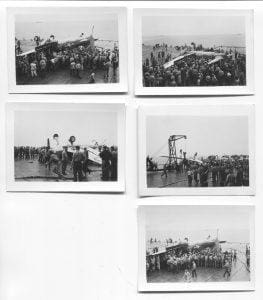
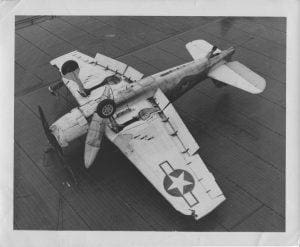
Rotating over the first barrier, my Hellcat was airborne again, tail first and upside down, just high enough to clear the second barrier, as I later learned. Slamming onto the deck, still upside down, the aircraft skated into the third barrier, which finally stopped its momentum. Everything went black—
**********
“Dad! Dad!”
I opened my eyes. The museum guidebook lay on the floor. My sons were crouched down, peering into my face with worry. Several museum volunteers stood about looking concerned.
“Should we call the squad?” one asked.
I shook my head vigorously. My mouth was dry and my hands were sweaty. “Water,” I croaked.
Someone gave me a bottle of water, and I took a pull on it.
“No. No squad. I’m—fine. I’m fine. Guess I just fell asleep.”
“Are you sure, Dad? Are you okay?” my eldest asked.
“Oh, yeah. Ready and raring to go.”
“Okay,” he said dubiously, studying my face.
He put the guidebook on my lap, and I said, “C’mon, boys. Let’s go look at the shuttle.”
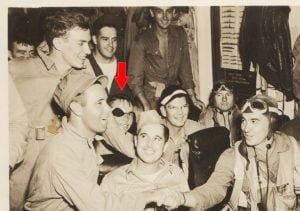
As they wheeled me away in that blankity-blank wheelchair, I glanced back at the Hellcat and smiled.
[Editor’s Note: Stay tuned for the epilogue, to be posted in several days, in which I’ll take a few paragraphs to indicate what parts of this tale are actual history, and what parts are fiction. Most of it is history.]






